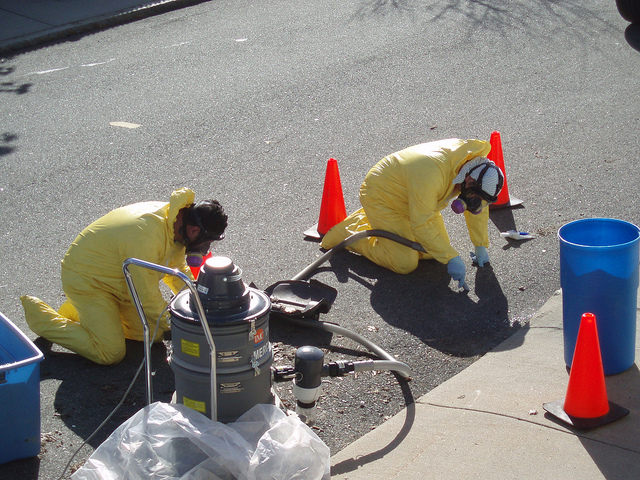STP Launches New Online Gap Analysis Tool
Auditors and Quality Managers across all manufacturing and service industries use ISO and OHSAS standards to put their Environmental and Health and Safety Management Systems into practice. These standards help implement effective and efficient EHS requirements, or VPP Occupational Health and Safety Management Systems. In this blog I review and summarize the two standards, their aims and obligations.
Read More
Tags:
Corporate Governance,
Business & Legal,
International,
Health & Safety,
Environmental risks,
Environmental,
EHS
In September I blogged about OSHA’s Airborne Contaminant Standard, which sets ambient air limits for over 400 workplace air contaminants to protect employees from exposures to airborne chemical and particulate contaminants in workplace air. In October, OSHA issued an extensive Request for Information (RFI), asking for comments on a variety of approaches to setting these limits in the future. In the RFI, OSHA notes that most exposure limits date from 1971, and so they don’t reflect four decades of advances in understanding of chemical toxicology. OSHA is attempting to build on legal requirements for standard-setting developed by court cases since 1971, and to update—the agency doesn’t say finesse—some of the limitations. The RFI asks over 50 questions, and solicits comments no later than April 8, 2015.
Read More
Tags:
Corporate Governance,
Business & Legal,
Health & Safety,
OSHA,
Environmental risks,
Environmental
Although most “workplace violence” incidents are low-level psychological or physical altercations between co-workers, Canadians have just been tragically reminded of the dangers of murders by interlopers. Government buildings are the likeliest targets for terrorism, and financial and retail buildings the likeliest targets for non-political criminals, but all workplaces face at least some of these most severe risks. There’s no way to eliminate these risks, but commonsense workplace security measures can reduce them. This note discusses approaches to evaluating and reinforcing security against external threats – which are important subsets of broader workplace violence prevention efforts.
Read More
Tags:
Corporate Governance,
Business & Legal,
Employer Best Practices,
Health & Safety,
Employee Rights,
Workplace violence
Every employer probably should know that employees have a right to receive at least the “minimum wage” for the hours they work. But employers may or may not focus on the fact that there’s not just one “minimum wage” – there are many, depending on the jurisdiction, the employer’s business or governmental sector, and the employee’s status. The federally-mandated minimum wage for most employees is $7.25 per hour (set in 2007 under the Fair Labor Standards Act (FLSA)), but some categories of workers can be paid lower wages, and some states require higher wages. Employers with scattered and diverse activities and work forces need to track developments under each applicable situation.
Read More
Tags:
Corporate Governance,
Business & Legal,
Employer Best Practices,
Employee Rights
Most Occupational safety and Health Administration (OSHA) electrical safety and machine guarding standards apply to protect employees from electrical and kinetic energy hazards during routine operations. But OSHA also requires protection during equipment servicing and maintenance, lest employees be injured by “unexpected” equipment energization, start up, or release of stored energy. OSHA’s Control of Hazardous Energy Standard—more often called the Lockout/Tagout or “LOTO” Standard after its primary compliance requirements—requires employers to establish and implement safety procedures to control such hazardous energy.
Read More
Tags:
Corporate Governance,
Business & Legal,
Employer Best Practices,
Health & Safety,
OSHA,
Employee Rights,
Environmental risks,
EHS,
Hazcom
The Occupational Safety and Health Administration (OSHA) has long required all employers to report work-related accidents that result in three or more deaths or serious injuries (what OSHA calls "catastrophes"). On September 18 OSHA published changes to these requirements that expand employers’ reporting requirements effective January 1, 2015 (I blogged about OSHA’s proposal here).
Read More
Tags:
Corporate Governance,
Business & Legal,
Employer Best Practices,
Health & Safety,
OSHA,
Employee Rights,
Environmental risks,
Environmental,
EHS
OSHA regulates workplace air contaminants to protect employees from exposures to airborne chemical and particulate contaminants in workplace air. Generally, employee exposures are limited by permissible exposure limits (PEL) based on a time-weighted average (TWA) over an 8-hour workday. OSHA also allows exposure to some contaminants at greater “excursion limits” for short periods of time, subject to “ceiling values.” Many of these limits are based on voluntary standards developed by the American Conference of Governmental Industrial Hygienists (ACGIH).
Read More
Tags:
Corporate Governance,
Business & Legal,
Employer Best Practices,
Health & Safety,
OSHA,
Employee Rights,
Environmental risks,
Environmental,
EHS,
Hazcom
Important Clean Air Act (CAA) elements direct the US Environmental Protection Agency (EPA) to reduce emissions of hazardous air pollutants (HAPs). Unlike the conventional pollutants associated with regional problems such as smog or acid rain, HAPs represent a list of 187 specific air toxics that can be harmful in low concentrations in much smaller areas. HAPs are subject to tighter controls and lower permitting thresholds.
Read More
Tags:
Business & Legal,
Health & Safety,
Environmental risks,
Environmental,
EHS,
EPA,
Greenhouse Gas,
ghg,
Hazcom,
mact
The Clean Water Act (CWA), as amended after the Exxon Valdez spill by the Oil Pollution Act of 1990, imposes oil spill planning requirements on onshore and offshore facilities involved in the handling and transport of oil. These facilities may be required to prepare and implement a Spill Prevention, Control and Countermeasure (SPCC) Plan (and perhaps a more detailed Facility Response Plan). During 2001-2011, EPA adopted a series of significant changes to its SPCC Plan regulations, requiring compliance by most facilities no later than November 10, 2011.
Read More
Tags:
Business & Legal,
Health & Safety,
OSHA,
Environmental risks,
EHS,
EPA,
Underground Storage Tanks
In August 2013, President Obama issued an Executive Order directing federal regulatory agencies to review specified regulatory programs that are designed to prevent catastrophic releases of toxics: Occupational Safety and Health Administration (OSHA) Chemical Process Safety Management Standard (PSM); Environmental Protection Agency (EPA) Accidental Release Prevention (ARP) program and Emergency Planning and Right-to-Know Act (EPCRA) program; and Department of Homeland Security (DHS) Chemical Facility Anti-Terrorism Standards (CFATS) program (I blogged about the EO here, OSHA’s consideration of PSM changes here, and about one of the agencies’ joint reports on progress here). EPA has just issued a request for information on the possible revisions to ARP requirements, which are described below.
Read More
Tags:
Corporate Governance,
Business & Legal,
Health & Safety,
OSHA,
Environmental risks,
Environmental,
EPA










